#but they can conjure a sort of shadow projection of themselves to fight with the weapon
Explore tagged Tumblr posts
Note
Question about the RPG AU... can IK and the brothers communicate while they're in weapon form??
oo, good question! my idea for this is this au's equivalent to pacts, which we'll call 'weapon seals' - so, ik can wield the brothers without the seal, but only as regular mundane weapons; once they've given her their seals, she then can access their powers and communicate through a sort of mental link
on the subject of the brothers' weapons though, here's another idea i had: to 'recharge' them after a battle, ik has to do maintenance that sorta corresponds with their power - lucifer's is light, so she has to leave him out in the sun, levi's is water, so she puts him in the bath
#answering asks#anon asks#rpg au#jtta aus#if belphie's power is ice he gets put in a bucket of ice and if it's air he gets strapped to a windmill#the brothers only realise they need this maintenance once they form their seals and actually get wielded#(they can technically wield themselves; their actual self is condensed in the weapon#but they can conjure a sort of shadow projection of themselves to fight with the weapon#they're not as strong this way though since a portion of their power goes into conjuring said shadow
16 notes
·
View notes
Text
Precure Day 187
Film: Yes! Precure 5 The Movie: Miracle Adventure in the Mirror Kingdom! Date watched: 16 May 2020 Original release date: 10 November 2007 Screenshots: https://imgur.com/a/OLloFxz (500 pics for you to enjoy!) Project info and master list of posts: http://tinyurl.com/PCDabout
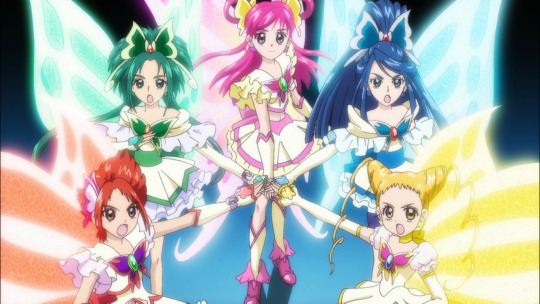
these butterflies will kick your ass
This continues our trend of absolutely excellent Precure movies, and stands strong with themes of love, compassion, and bettering yourself. It also introduces Dark Precures for the first time, who will go on to be a recurring idea for a few years. As always it has excellent animation and a moving plot to keep you invested so let’s explore and then I’ll tell you what I thought.
But first, a note! Throughout this review, I will refer to the villain Shadow using the singular "they” pronoun because their gender is never specified in the film. They have a mostly androgynous appearance, with some traditionally masculine features but a distinctly feminine voice provided by veteran seiyuu Park Romi, and they speak using the feminine pronoun “atashi.” Perhaps the animators were designing a gender-neutral character, or perhaps I’m reading too much into it and the character was meant to be an effeminate man. There is a long and complicated history of queer-coding villains in media that I don’t want to get into, so I’m just going to stick with “they”. However, the translation I use in my screenshots opted for he/him, that is out of my control.
The Plot
Before the actual movie begins, there’s a short sketch with Coco, Nuts, and Milk explaining what Miracle Lights are and how and when to use them. (more on that here) When they explain why you shouldn’t throw them, the audience is gifted with this nightmare-inducing image of Coco being cut.
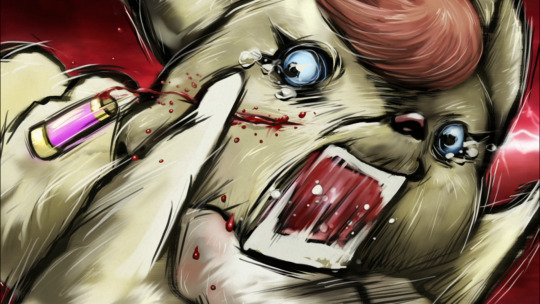
you know, for kids
After they get the do’s, don’ts, whens, and whys out of the way, the movie starts for real.
In the throne room of the Mirror Kingdom, which is an ominous land filled with reflective surfaces, a blue-haired Jojo villain named Shadow bosses around two bears named Migirin and Hidarin and has them conjure up an image of Nozomi. Shadow takes Nozomi’s image and reflects it into one of the five color-coordinated crystals that decorate the throne room. Nozomi’s image quickly turns into a full figure within the crystal, and as Shadow channels power into it, the crystal shatters and a dark version of Cure Dream is born. The camera leaves the castle and shows a desert filled with mirror slabs with sleeping anthropomorphic animals trapped inside of them.
Via a very clever set of establishing shots through a series of mirror reflections, we transition to Natts House where the five girls and Milk are hanging out. Nozomi is bored and looking for something to do, and each of her friends suggests an activity (futsal, watching TV, playing cards, or doing homework) but she rejects them all. Coco pulls out a flier for a place called Princess Land and suggests they go there. All the girls are entranced by the idea and they agree to go.
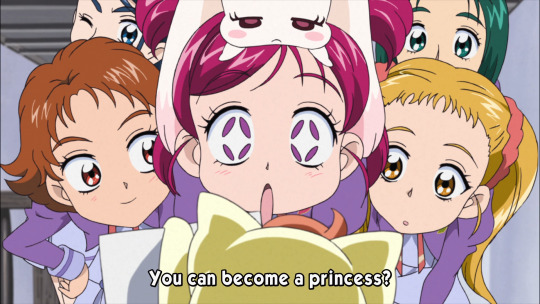
The opening theme plays over a montage of them traveling, arriving, picking dresses, leaving to change, showing off to Coco and Nuts, and then walking down a path with a huge crowd of people, including some costumed characters of bear princes. And then a mysterious gothic lolita girl appears on a nearby rooftop, looking out at everything...
The girls wander around Princess Land, acting like princesses while being silly with each other, Urara brags about a Pinky that she caught earlier, Nozomi tries to sneak up on Coco but he comments that he can tell when she’s nearby, and occasionally the mysterious girl from the roof walks by and steals glances at them. The girls enter a house of mirrors, and at one point, the mysterious lolita appears behind Nozomi’s reflection in the mirror, along with Migirin and Hidarin.
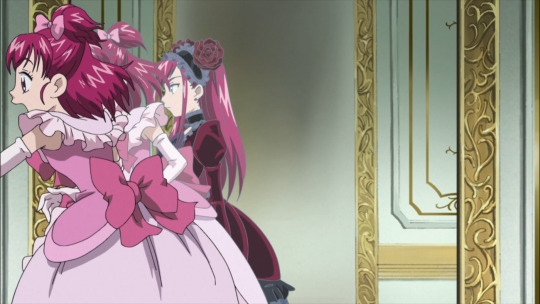
all of these are perfectly normal events
In the next room, Nozomi and Coco have a heart-to-heart, reiterating their feelings for each other and that they will find each other if they ever get separated. Afterwards, Nuts stays to talk with Coco, cautioning him about making that sort of promise since they’ll have to go back to the Palmier Kingdom soon. While they’re talking, Migirin and Hidarin sneak up from inside the mirror, take control of Coco and Nuts’s reflections, and then pull the real Coco and Nuts into the mirror world. The girls make their way to the exit, followed by Coco and Nuts. Nozomi notices Nuts is smiling, which is uncharacteristic for him.
Next, all the girls partake in a game where they run around a field as boys try to place flower crowns on their heads. Karen and Komachi are already out by the time we see them, Nozomi and Urara don’t last long, but Rin dodges and outruns all the boys, because she is too good for them. She receives a bouquet for her trouble, which she goes to offer to Nuts. However, Nozomi has noticed that Coco and Nuts aren’t acting themselves, and when Coco brushes Rin aside and asks Milk for the Dream Collet (side note: why does she have it? Nuts is its caretaker), Nozomi steps in and exposes the princes as imposters. While this is happening, the mysterious lolita watches from a distance.

The fake Coco and Nuts pull out a pair of Kowaina masks and morph into a large two-headed creature, so the girls all transform into Precure as well. The monster is very blobby and absorbs their attacks. Nozomi fires off a Dream Attack into one of the masks but when the smoke clears, the face recovers. While the girls fight, the lolita girl holds up a mirror that captures their images, and Shadow reflects Rouge, Lemonade, Mint, and Aqua into the remaining four crystals. With her work done, the lolita disappears back to the Mirror Kingdom. The Precures continue to fight, unaware of the malicious plans afoot. Aqua concludes that if they attack both masks at once, they should be able to defeat the Kowaina, so after Dream, Lemonade, and Mint gain the upper hand, Rouge and Aqua swoop in with their special attacks. As the monster disappears, what’s left are.... Migirin and Hidarin! They try to flee but Rouge captures them and takes them back to Natts House. There, the girls interrogate them about the location of the real Coco and Nuts. They’re reluctant to talk until Milk slaps the shit out of them.

They explain how Shadow took over the Mirror Kingdom, imprisoning all the residents and stealing the kingdom’s crystals, the source of its energy. Shadow then promised to return everything if Migirin and Hidarin were able to get the Dream Collet. Coco and Nuts are being held captive in the Mirror Kingdom, and there are specific conditions to get there that involve the Miracle Lights which Migirin and Hidarin have. So the girls get ready, and at 2 AM they depart. But they barely have time to take in the sight of the desolate kingdom before Shadow appears in the flesh, claiming that they can get whatever they desire with the Dream Collet! The girls transform into Precure, but Shadow smugly says the Precures won’t be fighting them, and then they teleport the red, yellow, green, and blue crystals behind themself. The mysterious lolita girl also appears behind Shadow, and Nozomi is shocked at this girl who looks so much like her. The lolita is encompassed in flame as she transforms, revealing herself as Dark Dream.
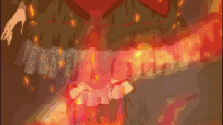
At the same time, the other four crystals burst and Dark Rouge, Dark Lemonade, Dark Mint, and Dark Aqua emerge.

Color-coded mirrors appear behind the heroine Precures as their dark counterparts quickly lunge at them and pull each of them into a mirror, where they each arrive in a new dimension. The Dark Precures speak to their originals about their twisted ideals, which all share the common theme that the Dark Cures believe friends are worthless and the clones are better because they don’t have that reliance on others. Each girl engages in battle with her doppelganger and the Dark Cures waste no time demonstrating their superiority.
Milk, Migirin, and Hidarin can do nothing but watch the mirrors. Shadow, however, isn’t interested in waiting to see the outcome of the fights, so they forcefully take the Dream Collet from Milk and teleport back to the castle. There, Coco and Nuts are shown trapped in mirrors, and Shadow taunts them before explaining that they came to the Mirror Kingdom so they could quickly collect all 55 Pinkies. They hold the Dream Collet up and the mirrors scattered around the room change to show all the Pinkies scattered around the world (very convenient that they’re all by reflective surfaces). They get sucked into the mirror, into the Mirror Kingdom, and then into the Dream Collet! Coco is sad because he’s helpless to stop this and thinks he may never see Nozomi’s smile again.
The Dark Precure fights resume, and they’re getting brutal, but the tide is starting to turn in favor of our heroines. Dark Dream says she’s an exact copy of Nozomi, but without her weaknesses. However, Nozomi turns it around and says Dark Dream is a clone of a past version of her, she continues to improve herself and she’s stronger than she was yesterday, an hour ago, a minute or even a second ago. It’s a damn good line.
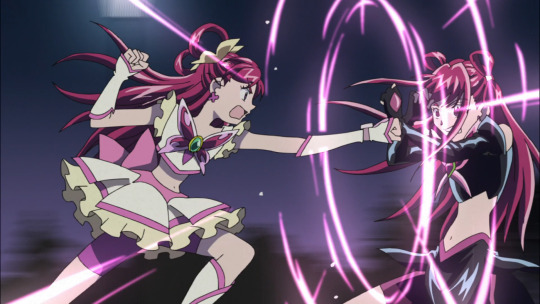
The other girls also question the motivations of their counterparts and explain that having friends is what motivates them and makes them strong. We cut back to Milk and the bears. Milk wants to follow Shadow to save Coco and Nuts and recover the Dream Collet, but Migirin and Hidarin are too scared to go with her, feeling too weak and pointing out even Precure couldn’t do it. Milk scolds them for not wanting to save their own kingdom and sets off on her own. She makes it to Shadow’s castle, and Migirin and Hidarin show up after all to help her.
Nozomi and Dark Dream continue to fight, and Dark Dream’s confidence gives way to anger, confusion, and grief that she doesn’t have anyone she cares about like Nozomi does. Rin, Urara, Komachi, and Karen all manage to defeat their dark counterparts with the strength brought on by their friendship and confidence, recovering the crystals used to create them in the process. Dark Dream attacks Nozomi out of desperation but her heart isn’t in it, and Nozomi effortlessly swats the attack away. Dark Dream falls to her knees, crying about not understanding human feelings like love and friendship, and instead of fighting her, Nozomi offers her a hand and says she can learn, that Nozomi can teach her, and then invites her to return to fight Shadow with them. In the desert, all five mirrors break and the girls emerge from them. Rouge, Lemonade, Mint, and Aqua are surprised to see Dark Dream come out with Dream, and Dark Dream is clearly uncomfortable, but Nozomi says she’s a friend and that’s the end of that. The six girls run off to Shadow’s castle, and arrive just in time to save the mascots from a destructive attack by Shadow. However, Shadow boasts that it’s too late because they’ve already collected all the Pinkies, and they make their wish to become the ruler of the world. Power courses into the Dream Collet, the cures brace themselves, and then.... nothing happens.

Lemonade remembers the Pinky that she caught earlier which is still in her Pinky Catch, so Shadow can’t have all 55 of them and therefore their wish didn’t come true. Undeterred, Shadow lashes out at the team, lunging straight at Dark Dream and brutally punching her in the stomach, but quickly separates the other girls, and paralyzes Dream. Shadow moves to destroy Dream but Dark Dream moves in front of her and takes the blow instead, cracking the jewel in her chest. Nozomi is freed from the restraint and holds her copy in her arms, begging to know why she saved her. Dark Dream responds that it’s because she likes Nozomi, and after all, she’s just a copy. Nozomi says she’s not a copy, she’s her friend, but it’s too late, and Dark Dream starts to glow and fade away, leaving behind only her crystal. Shadow remarks that Dark Dream was a traitor who had it coming, but Nozomi will not take this slander against one of her friends, and through her tears she fights Shadow, delivering a good kick to their stomach before performing Crystal Shoot, seemingly defeating the villain.
Dream turns to Migirin and Hidarin and asks them to use the Miracle Lights to free Coco and Nuts, which they do. She embraces Coco and reminds him that she said she’d find him, no matter where or how. Their reunion is short lived, though, as Shadow stands up, cursing the Precures, and transforms into their true form: giant, buffer, and now with long red hair for some reason. They attack the Precures, and then launch a huge energy ball, but Migirin and Hidarin step in to block it with the Miracle Lights, proclaiming that they’re no longer afraid of Shadow. Then they turn their miracle lights on the Precure, wishing to grant them the strength to defeat Shadow. Migirin and HIdarin aren’t strong enough, so they ask for help. Coco, Nuts, and Milk help to! So does the audience! You! Yes you reading this right now, wave your miracle light and give the Precure power!

Well everyone’s wishes come together to grant the Precure new power, and they metamorphose into Super Precure. (I’m serious, they literally cocoon up and then emerge with new outfits and sprout butterfly wings.) Then they perform Precure Five Explosion, against Shadow’s protests of overwhelming power. They explain it isn’t just their power, but the power everyone gave them, the power of everyone’s hearts and courage becoming one! Shadow is no match for the combined strength of everybody, and disintegrates.
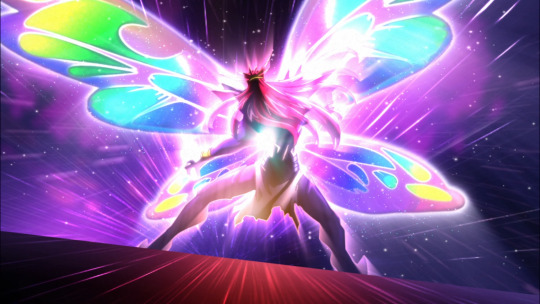
Afterwards, the cures use their butterfly wings to carry the five crystals back to their pedestal mounts in the throne room. The pink crystal notably has a large fracture in it, a lasting reminder of Dark Dream’s short and tragic existence. With all the crystals restored, the Kingdom of Mirrors returns to its natural beautiful state, a land of greenery and crystals poking up from the ground, and the inhabitants are freed from their prisons. Urara, Komachi, and Karen comment on how beautiful it is. Inside the throne room, Nozomi stares wistfully at the pink crystal, recalling her short-lived friendship with Dark Dream. Rin and Urara call her to go to the celebration party, and as she runs out of the room, the camera does a slow zoom in on the cracked crystal while the ending theme begins to play.
The ending itself is Ganbalance de Dance again, but the girls are in their princess gowns, while the fairies are wearing their corresponding garb, and Migirin and Hidarin make a few appearances.
vimeo
The Analysis
The three movies from the “Futari wa” shows in 2005-2006 were all about the girls overcoming internal conflict to become better friends with each other, and each of them did it in a somewhat different way. You could certainly explore that dynamic with a larger team, and in fact the show did just that in episodes 23-24, but instead this movie derives its conflict from the girls’ own personalities. They’re not fighting each other, they’re fighting themselves, and recognizing their supposed weaknesses as strengths. In this way, they achieve growth. It’s a great character exploration and shows what teamwork means in a larger group setting. Additionally, the story is well-paced and flows naturally from one event to the next without ever lagging, but it also gives you some necessary breathing room in between dramatic moments. As we’ve come to expect, the animation is generally much better than the television series, and the fights look phenomenal. The aspects I find less enjoyable are mostly to do with the fairies and the merchandising, and a bit of a rushed finale.
The major themes of this movie are friendship, trust, redemption, and growth. Friendship is the most obvious one, because it’s at the core of this entire franchise. The bond that each member of the team has with the others is their greatest strength and what allows them to push past their own limits. It’s what clues Nozomi in that Coco and Nuts are missing. It’s what the Dark Precures are missing which leads to their defeat, and it’s also what allows Nozomi to befriend Dark Dream rather than defeating her. We are shown time and again that having people to support you is the most wonderful thing imaginable. Trust is perhaps both the most broad and the most limited theme in this film. It’s closely connected to friendship and you can see it overlap with that a lot. Because of their friendship, each girl trusts that the others are winning their battles against their counterparts as well. However, a small place where it heavily applies that’s easy to overlook is during Nozomi and Coco’s moment alone in the hall of mirrors. They promise they’ll always find each other no matter what they look like or where they go. True to her word, as soon as Nozomi realizes Coco has been replaced with an imposter, her only goal is finding the real deal, and Coco has unwavering trust in her to do it. It’s a powerful moment that gets lost in the commotion of the movie, but I love it.
The Dark Precures are easily the most famous aspect of this film, with good reason. The idea of an evil twin is an ancient storytelling technique, and it remains very effective, because it can simplify character design by allowing you to base your evil character on an existing protagonist while letting you deviate in small or large ways from their design as needed. It's also be a convenient way to explore and develop a character’s personality by having them face off against someone of a similar, but twisted, ideology. A case could be made that the Kiryuus in Splash Star were a form of villain counterpart Precures without being explicit copies of the heroines, but these are the first to be directly and transparently copies of the heroines, and of the three full dark teams as of this writing (Yes 5, Heartcatch, and Smile) they’re the best fleshed out. Each of them represents a quirk of their doppelganger, but turned selfish.
Dark Dream is devoid of aspirations and joy
Dark Rouge believes friends prevent you from being your true self
Dark Lemonade feels that trying to entertain others is a waste of effort.
Dark Mint believes the best defense is a good offense, and protection is a weak ability
Dark Aqua thinks that friends keep you from growing stronger
They gloat about being better because they don’t have the dependency on friends, but most of them go down precisely because the heroines feel empowered by being in a team, even when fighting alone. Each of the heroines recognizes that their strength comes from having friends to protect and fight alongside, that friends help you grow and improve yourself. The hubris of the Dark Cures is ultimately their undoing and it ties back into the film’s central themes of friendship. This is explored clearly across all five fights by careful editing, which involves giving each battle a little bit of time in focus before changing perspectives. We hear short exchanges between the original and dark cures, and sometimes conversations are continued between battles, as their debates are very similar. Ultimately, the Cures’ confidence in their friends is what allows them to succeed over their counterparts, as just having faith is enough of a motivator and a power boost to keep them going, and each fight concludes with the girls accepting and explaining how the flaw the Dark Cures see in them is actually their greatest strength. It’s beautiful. I was particularly moved by Komachi and Karen’s statements to their doppelgangers. Komachi said “I wanted to protect you, too,” as Dark Mint disappeared in her arms, which is a powerful rebuttal to an opponent who criticized her for only protecting herself, and you could feel Komachi’s regret. Meanwhile, Karen told Dark Aqua that her dark version reminded her of herself before she made friends, and therefore she wants to surpass that version of herself, which speaks to Karen’s growth both on and off the screen.
Nozomi and Dark Dream’s battle, however, is on a different level from the others. Dark Dream was actually a reflection of Nozomi herself rather than Cure Dream, she was around for longer than the others and got to see Nozomi just hanging out with her friends being happy, so she has the most fleshed out personality and perspective while the rest of the Dark Precures were created and immediately thrown into battle. Consequently, Dark Dream starts out cynical about Nozomi’s friendships, but when Nozomi begins to show how her friends help her grow and improve herself constantly, Dark Dream begins to falter. Her confidence turns to anguish as she bemoans her lack of understanding about friendship, happiness, laughter, sadness, sorrow, or any other emotions. She was created to fight and that’s all she knows how to do. But instead of destroying her, Nozomi offers to help her learn these things, and this act of kindness shakes Dark Dream to her core. Her reason to exist has been stripped away, but Nozomi has given her a chance to be more than just a clone made for destruction. More amazingly, the other Precures accept her as well. As soon as Nozomi declares her a friend, they all accept her as one of their rank and proceed to fight Shadow. For the first time in her life, she’s not just needed, she’s wanted, and this shows off the depths of Nozomi’s compassion and her power to unite people. Unfortunately, just when Dark Dream has found someplace she belongs and people who care about her, she makes the ultimate sacrifice to save Nozomi, and that breaks my heart. Her story mirrors that of Kiriya, someone else who was created for evil, but through the compassion and kindness of the heroines, tried to forge a different path, only to die before he could truly make a new life for himself. It’s the same kind of tragedy, that of unfulfilled potential, and it’s a mature plot direction for this series. It hurts but I applaud the writers for it. I also love that Nozomi doesn’t forget this at the end. Nozomi made a new friend, that friend died so she could survive, and the ending where she stares at the pink crystal with only the bottom of her face visible really gets to me. I’m not sure if it’s symbolic that she’s lost a part of herself or if it’s because eyes are major sources of expression and hiding them enforces that she’s not her usual happy self, but it’s excellent framing and it contrasts well with the happy face she puts on when Rin and Urara summon her for the party.

Additionally, this scene of Dark Dream’s desperate attack is beautiful, primarily in how the audio cuts out from the moment she throws it until it hits the ferris wheel. It’s an excellent use of silence.
vimeo
Beyond having ideals that clash with those of the Precure 5, the Dark Precure also have their own spin on special attacks. The butterfly motifs are gone entirely, Dark Dream simply lobs a ball of energy around, Dark Rouge shoots fireballs and can use a phoenix attack, Dark Lemonade creates blades by kicking her feet and can decimate with her singing, Dark Mint launches orbs that can pierce barriers, and Dark Aqua uses an energy staff, and later a sword. In some respects they resemble the Cures’ attacks and in others they’re completely opposite. It’s a clever and imaginative use of each girl’s powers.
The combat sequences are some of the best I’ve seen in any movie so far, with the characters alternating between rapid-fire punching and kicking and their energy attacks. Each battle takes place in a unique environment, which lets the perspective switch rapidly between fights without confusing the audience, and the director keeps an excellent balance between them, only staying a few minutes at each before changing perspective. Dream fights in a carnival, primarily by a ferris wheel (which could be the one seen at the Princess Land), Rouge fights in space on a bunch of floating orbs, Lemonade and Mint both fight in cities surrounded by buildings and parks, and Aqua fights in a flowery meadow.




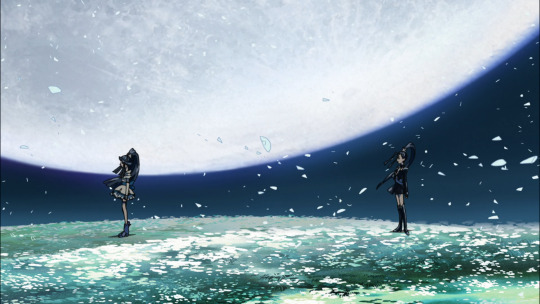
The other villain of the movie, Shadow, offers very little to discuss. They’re a power-hungry tyrant with no motivation other than to rule over everything. They’re super over-the-top in their mannerisms, very sadistic, mocking, and uncaring about anybody else. They view the Dark Precures as nothing but tools and they feel no remorse for their defeat. We know nothing about their history or what led them to become this way, and since most of the movie is them pushing other people around or letting the Dark Cures fight on their behalf, we don’t get the chance to explore their motivations deeper than the surface level. Shadow is a decent fighter, at least, when they go toe-to-toe with the Precure they demonstrate immense speed and of course their glyphs are able to both restrain opponents and teleport small objects. It’s good to have a five-on-one fight against a human-sized opponent after spending half the movie in solo fights, it shows how strong Shadow is, but ultimately of course the Precure overpower them, driven on by the death of Dark Dream. I enjoy seeing them gloat and ham it up but they’re less compelling than their predecessors Sirloin, Freezen and Frozen, and maybe even the Dark Witch. This of course is due to Shadow’s lesser screentime, since the Dark Precures are the main attraction of this film, but I still wish they’d gotten a little more time in the limelight.
The other new characters of this film are the denizens of the Mirror Kingdom, Migirin and Hidarin. They are annoying and I do not like them. I take pleasure in seeing Milk slap the shit out of them.
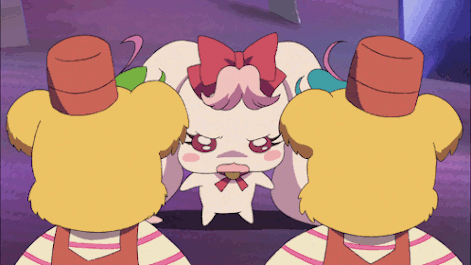
They are voiced by a comedy duo called “The Touch” who are real-life twins named Takuya and Kazuya. Their line delivery is very bland and, frankly, they’re boring characters. Their main gimmicks are speaking in sync or finishing each other’s sentences, and their only character trait is cowardice that they have to learn to overcome. Beyond that they’re only in the movie to have an in-universe explanation for the Miracle Lights.
Let’s address the elephant in the room here. This is the very first Precure movie to have Miracle Lights. Almost every movie after this will also include a new Miracle Light, so get used to them. I wrote a long explanation on PCD Status that you can read, but the short version is that kids in the audience receive a real Miracle Light with their ticket purchase, and at key points in the movie they’re supposed to light it up and wave it in the air, giving the Precure power in a simple form of audience participation. In this film they mask the fourth wall breaks pretty well by having Nozomi turn towards the fairies when she asks for help, even if she’s facing the camera. It’s just enough plausible deniability to not break the immersion.
The plot of the film is really good until about the last fifth, and then as I alluded to earlier it gets rushed and kind of muddy. The entire prologue and the sequence at the Princess Land is the kind of wonderful fun, comedy, and antics I’ve grown to expect from this show. It highlights all their characters wonderfully and you get some small, tender moments as well. Karen and Milk’s close friendship is on full display, Komachi pushes Nuts away from a mirror that makes the viewer look fat because she doesn’t want to see him that way, and of course there’s Nozomi and Coco’s comments about detecting and finding each other. My two personal favorite shots are the bit with Urara, Komachi, Karen, and Milk performing a hime laugh because it’s just so wonderfully absurd.
youtube
And then my other is personal bias, but during the princess crowning, Rin manages to outrun all the boys. If you’ve been in the fandom you may have heard the joke “Nobody loves Rin,” which relates to the other four girls each having an official or widely accepted shipping partner (Nozomi and Coco, Urara and Syrup, Komachi and Nuts, Karen and Kurumi). Well my rebuttal to this, based on this scene, is that Rin has no partner because there’s nobody good enough for her yet. We stan best girl!
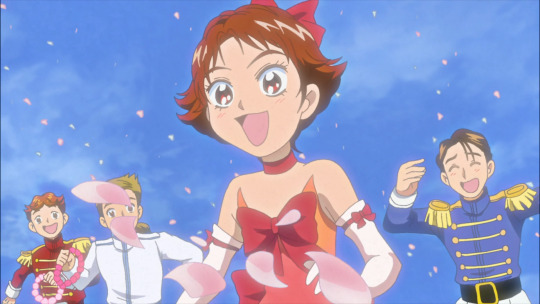
The interrogation at Natts House is good, and of course when they arrive in the Mirror Kingdom they’re almost immediately confronted with Shadow and the Dark Cures, who I gushed about above. The part where I believe the film starts to crack just a bit and the pacing hurts is after the defeat of Dark Dream. Shadow goes down really quickly, and then once the team turns into Super Precure, they almost immediately perform Five Explosion. From the time the six girls confront Shadow in the castle to Shadow’s defeat is about 10 minutes of a 70 minute movie, and 5 minutes in the middle of that is Miracle Light shenanigans and Shadow transforming. Most of the rest of the fight is the Five Explosion stock sequence, and whereas normally the Cures would deliver some epic speech before they land the final blow, this time their righteous lecture is rather short, saying that the power is everyone’s power. It’s effective but it feels truncated.
I found the soundtrack to this movie to be.... largely uninspiring. It wasn’t bad or anything, but it just seems to be remixed or rerecorded tracks from the show’s BGM., but listening to the OST there was only one track that really hit that sweet spot in my brain. It’s “Surpassing my Past Self”, track 18, and I like how everything in it builds up. You’ve got strings for the melody backed by rhythm guitar, joined later by brass, and then the guitar starts to take a more active role in the tune as it ramps up in intensity. This is the song that plays when Nozomi is winning against Dark Dream and starting to persuade her, when she makes her epic speech about being stronger than she was before. This song sticks out to me in a way that nothing else does.
Visually the movie is gorgeous, with some occasional hiccups into TV quality, but of course the movie budget overall means they get to do more than they can with a weekly TV show. Check out the opening sequence and all the little details in it!
vimeo
I especially love this bit from just before the title card where the girls’ portraits flip around to show the dark cures.

you can find a higher resolution version of this gif in the gallery
Curiously, there are still some animation shortcuts taken, like during this shot where the camera zooms in on the double doors and you can clearly see the transition between the low-detail wide shot and the high-detail close-up. I know why they did it but I wish it was smoother.
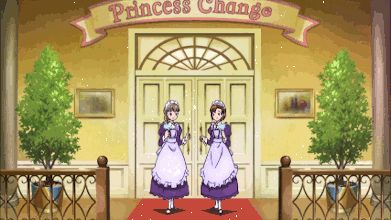
Something I find really clever is that when Shadow first creates Dark Dream in the pink crystal, the silhouette that is generated is just Nozomi in her school uniform, she doesn’t take on her new appearance until she’s fully formed.
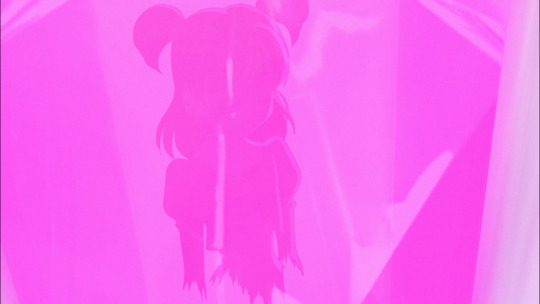
The designs of the Dark 5 are really good and I could probably gush about them for another week, but in a nutshell they manage to effectively invert the aesthetics of the Precures, replacing cream with black, and their outfits are different from each other’s in a lot of the same ways that the main team are. Dark Dream has a two-piece outfit, Dark Lemonade’s skirt is a bit different, Dark Mint and Aqua have a band of color around their waist that the others lack, things of that nature. They’re distinct from their counterparts and from each other, which is more than can be said about their dark successors.
Dark Dream, in her civilian guise, is also an incredible design. Gothic lolita is a great look and I think it’d be cool if the franchise would utilize it a little more often.

The lace-front maroon dress with a flower petal skirt is very nice, and the black petticoat accentuates it. The headdress with roses compliments the purple bow and also reflects Nozomi’s small pigtails, and her purple lipstick and eyeshadow bring it all together. It’s almost a shame she loses the makeup when she transforms.
The Super Precure designs are nice. Not as elaborate as the Phoenix Forms from the second Max Heart film, but I appreciate the subtle redesigns.

Obviously the butterfly wings are the most prominent element, but their sleeves are longer and frillier than on their normal outfits, which means the stock sequence for Five Explosion had to be largely reanimated..... and this means the coloring error with the Lemonade Castanet is fixed!
And my last art/animation comment is to point out that there sure are a lot of stomach attacks in this film!
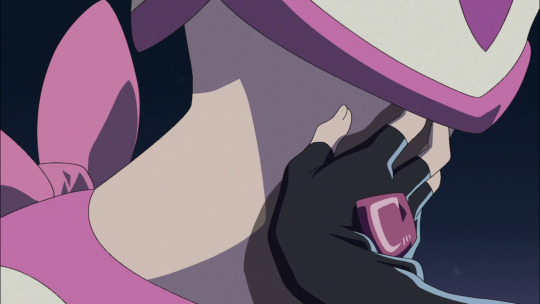



Some other bookkeeping: the Dark Precures are voiced by different actresses than those who play the protagonists, and this is the only time that happens, because future Dark Cures will share an actor with their counterpart. Some of them have had supporting voice parts in previous Precure seasons, and all five of them will have roles in future seasons, though again some are small parts. The most notable ones are Nishimura Chinami as Dark Dream, she would later play Aoki Reika/Cure Beauty in Smile Precure (and therefore Bad End Beauty as well); and Kugimiya Rie as Dark Lemonade, who later portrays Madoka Aguri/Cure Ace in Dokidoki Precure. The others are: Minaguchi Yuko as Dark Mint, who plays Flora in Precure 5 GoGo; Kiuchi Reiko as Dark Aqua, who previously played Kiriya in Futari wa Precure, and Nagasawa Miki as Dark Rouge, both of whom will play characters-of-the-week in Heartcatch Precure.
By the way, according to the Precure Wiki, there was a scene after the credits in the theatrical version that showed the Dark Precures being revived, however I cannot find any legitimate citation for this, and it’s also not mentioned in the Japanese wikipedia article for the film, so I’m considering that claim false unless more reliable information surfaces.
Overall this movie is excellent and once again it raises the bar for what you can achieve in a Precure movie. It features fun hijinks and high-stakes emotional drama! It tackles the doppelganger idea better than any subsequent series due to the possibilities of film and the artwork is great. If you haven’t seen it, go check it out!
Next time, in Precure Daily, we return to the main plot as Despariah appears before the girls! Look forward to it!
Pink Precure Catchphrase Count: 1 kettei!
22 notes
·
View notes
Photo


i. overview
Species: Vampyr
Full Name: UTP
Birthday & Age: UTP, 125+
Rank: UTP
Occupation: UTP at Six Crown Studios
Neighborhood: up to you or UTP, # bed(s) bath(s) - lives with UTP.
Residency Status: UTP
Sexual Orientation: UTP
ii. personality
+ trait, trait, trait, & clever.
- clandestine, trait, trait, & trait.
iii. about the species
vampyr is a preternatural being, commonly believed to be a reanimated corpse, which consumes the blood of sleeping persons at night, thralls, and other victims. undead, diseased people who have been predominantly hated, hunted, and misunderstood by the living. whether they consider themselves cursed or blessed, or whether they have given into their animalistic instincts or have sought to find a way to fit the norm, vampyrs are nonetheless considered abominations. the origins are obscured by misinformation and the past forgotten but many of their kin have select deities they worship close to the nocturnal affinity. hekate, anubis, ceres, gods who require blood of their patrons. still, they are species are old enough that not even the eldest of the community can remember their proper origins.
iv. the past
May 29, 1913. Paris. The Rite of Spring — a ballet that triggered a riot.
Ballet is typically thought of as harmonious, graceful, and refined. The first performance of Igor Stravinsky's “The Rite of Spring,” audience members were left stunned. Murmurs gave way to outrage that drowned out the orchestra. Fights were started and arrests were made. The world was on edge, standing on the precipice of a world war and ushering in the modern age, and they were truly captivated by the tension of it all.
They were there. They’ve always been there — found at the intersection of creativity (in all of its forms) and such unnerving beauty it has spun legends. There was something so visceral as the world broke out into such a reaction over the rejection of the expected beauty, romance, and elegance so intrinsic to the genre. In their long lost youth, at a fonder point of time, the public had been so passionate about classical music - and the arts, at length - that they were willing to riot at a performance. Their fascination has not wavered over a century as they continue in their quest for beauty and intrigue, but thrive on twisting and subverting it to their own standards.
v. the current
There is a longing for a busier life, but there is a novelty to be found in the more mundane. The world underestimates them. Their curiosity has bloomed along with a ravenous penchant to partake in all things creative. They have watched ‘modern’ become ‘classic’ over numerous decades, yet they are still at the forefront ready to push things further. There is an intrigue in the touch of chaotic neutrality they have been found to possess, but they have perfected the art of shrouding it in utter subtlety. Their heart still beats in a violent yearning to be consumed by all encompassing passion, sparked within themselves and others. The irony of what they have been tasked with by The Dominion is not lost on them — to continue to conceal the supernatural. Oh, but the riots that would ensue just might sway them otherwise!
vi. connections
✗ SIX CROWN STUDIOS - The company has enticed them in their endeavor to push boundaries, though they push against many things that have the audacity to try to hold them back. There are undertones within the studio to seek out the radical and the different. THE NUANCE has a passion project of curating profiles on individuals that challenge the fetters of social constructs, but they have happily become a chameleon of sorts. A large focus of the studio is flirting with the world of the supernatural and ultimately exposing it. THE DOMINION has tasked them with misdirection — offering a few anomalies to poke through while concealing the rest with sleight of hand. Should they be tempted to let things go awry, other species will certainly be the first to fall.
✗ THE BON VIVANT - They are THE BON VIVANT’S Right Hand holds quite an amusing secret. Unbeknownst to him, they are hiding in plain sight. They are of the vampyric sort. They lurk outside of the shadows of society and have mastered the art of fading into the background, yet are attention seeking in more subtle ways. THE NUANCE is walking and guarding a fine line. They exist entirely in a grey area and wield a paintbrush to paint things one shade darker when they decide. They are there to let some things slip while disguising others as the world isn’t ready for the veil between realms to be stripped away. They find the ignorance of humans both amusing and endearing. The Studio has come so close to exposing it all and they are there to prevent total chaos all under the guise of helping THE BON VIVANT. Should it all go belly up, they’ll be there to document it all going down in flames.
✗ THE INQUISITIVE - The BON VIVANT has tried in vain to conjure up some semblance of The Three Musketeers. THE NUANCE and THE INQUISITIVE play nice enough though rarely seek out each other’s company when THE BON VIVANT isn’t around. THE INQUISITIVE is the most earnest believer out of them all, but THE NUANCE has mastered the art of misdirection. There is suspicion and thin smiles amidst the forced pleasantries but neither are inclined to make waves, though causing ripples of amusement is another story.
Their face claim is UTP and they’re currently OPEN FOR AUDITIONS.
Suggested faceclaims: Ezra Miller, Brigette Lundy-Paine, Quintessa Swindell.
0 notes
Text
Feature: Black Lodge Meditations
Far from the offbeat humor of Nadine’s regression to her high school cheerleading days, past the precious teenage romance of Donna and James or the even more precious love triangle between Dick and Lucy and Andy, beyond Audrey’s sublimated longings for sex and companionship, beneath the money-grubbing and sometimes deadly Ghostwood Estates project, and even deeper than the bloody criminality of One-Eyed Jack’s, Twin Peaks harbors a darkness that overwhelms all its network television red herrings, its sub-sub-plots, its kitschy catch-phrase seeding. This darkness seems to be the one motif the show’s irony fails to master. It even overpowers its own dismissal as a cliché, as Lynch and Frost spend episode upon episode developing and deepening the metaphor of darkness and its looming power over the town and its environs. But what, exactly, is it? With so many images of darkness in the show, ranging from the strictly physical to the nearly mythical, the concept is mysterious, even as darkness is, in a sense, mystery itself. A mystery wrapped within its own layers, darkness is not necessarily evil, though evil often finds it suitable to cover its crimes; and though death may be a mystery of its own, it is only a relative of darkness, since death, or a death, can lead us into the dark night. Lynch and Frost’s construction of darkness often juxtaposes the dark with its old enemy the light, invoking the classic/clichéd dichotomy, but here even the light seems to be complicit within the show’s notions of darkness, especially in its own impotence in the fight against the shadows that take sanctuary within the darkness. In fact, few things have power against this omnipresent force, and those that do must take darkness within them in order to confront it — a dangerous proposition. This is a different sort of confrontation: to seek the heart of Twin Peaks’s darkness by encircling it from many sides. But it may be that the darkness has many hearts or that its darkest heart is hidden within layers and layers of darkness, down corridors we have not walked, behind curtains we have not drawn back. Take courage, regardless: whether few or many, vast or minute, shallow or profound, darkness lies ahead. --- 1. Wrapped in Plastic From the pilot episode Cast up from the dark lake, a form lies wrapped in plastic on a rocky beach. We watch as Pete, in the midst of his morning leisure, approaches the body, his face twisted in a mixture of horrified recognition and fearful curiosity. He knows what is hidden behind the semi-transparent sheets before he pulls them back, and all that stands between him and the darkness spilling over from the night before is a thin membrane. Like Laura’s mother, he already knows what lay there occulted on the beach, and yet he can’t prevent himself from peeling back the sheet to reveal the object of his horror: the truth, that the beloved Laura is dead. Pete’s horror is such that he struggles to speak. He can verbalize the facts: “She’s dead… Wrapped in plastic.” But in his desire to speak the name of the crime and inability to form the words to do so reveals a yet-deeper horror beyond the fact of her death. Laura’s death also contains something unspeakable, the dark mystery of which animates the entirety of the series. What agency has executed this deed, and more, what motive could have prompted it? As the investigation of these fathomless mysteries unfolds, the myriad secrets that once lay hidden under the cover of night now spill over into the light of day. The viewer first encounters Laura through a veil, an occulting screen. Her death, now discovered, is a mystery concealed behind another obscuring presence. The plastic sheet embodies the diaphanous darkness that conceals the mystery of Laura’s murder: the darkness that hides the crime but also announces it. With Pete, we first peer through the concealing element, and then, bravely, we see beyond it with him, uncovering the mystery to the light and to our collective horror. We have traversed the first corridor of the dark labyrinth concealing Laura’s murder and the forces behind it. Like the plastic sheet, the physical darkness of night conceals and yet also yields a deeper darkness, a darkness beginning with horror and never quite resolving. An abyss of secrets gapes beyond the screen. --- 2. Ghostwood Animation: Korey Daunhauer SHERIFF HARRY TRUMAN: There’s a sort of evil out there, something very, very strange in these old woods. Call it what you want. A darkness; a presence. It takes many forms, but… it’s been out there for as long as anyone can remember, and we’ve always been here to fight it. Twin Peaks is located in rural Washington on the border of Canada, in an area known for vast conifer forests, dark gray skies, and misty rain. The darkness of these pine forests is mythical. The Douglas firs Agent Cooper asks about in the pilot are dense with needles and staggeringly tall. Presumably, this is part of a survival strategy: the firs grow tall and close together to deprive other species of sunlight, allowing their kind to flourish. It’s said, however, that Douglas firs have poor shade tolerance themselves, making it hard for young firs to grow, so we know that the trees surrounding Twin Peaks must be ancient. Beneath these trees, on cutoff roads deep within the forest, in cabins hidden at the end of winding trails, there are numerous opportunities for solitude. The semi-permanent shadows these forests cast not only suggest the concealing power of darkness, but also the paranoiac mood it evokes. Forays into the depths of these places reactivates some animal part of the mind, which takes care against the dangers that may lurk behind the trees. That mystery, the uncertainty as to what the darkness conceals, is a constant, even while the characters of Twin Peaks seek answers to the central mystery of the show. Each character, insofar as they encounter darkness, forms their own relationship to it and thereby their own interpretation of it. Sheriff Truman views it as an evil presence, yet Major Garland Briggs and Agent Cooper seek it out with their evening of night-fishing. Agent Albert Rosenfield, the urbanite, refers to the darkness as “the evil that men do,” but we must wonder if it extends beyond that formula. It’s no coincidence that Laura’s body appears just outside the sawmill, near a massive piece of driftwood. The logging of Ghostwood forest disturbs the ancient darkness, transforming it into money (in the final episode of Season 2, this juxtaposition becomes explicit, as the cash from the exploded bank vault flutters down past the trees). An even greater transformation is lurking in the form of Ghostwood Estates, Ben Horne’s (and later Catherine Martell’s) real estate venture that hopes to cash in on the beauty of the area. Twin Peaks is growing, and as it grows, it encroaches into new territory, revealing some secrets best kept in the dark. This collision of the human with the primordial forest is in some ways the story of North America, but the darkness motif stretches beyond historical narrative into our own primordiality, our own fear of what lies hidden from view. --- 3. Laura Palmer’s Theme Animation: Korey Daunhauer If the setting of Twin Peaks conjures darkness as a mood, the undulations of Angelo Badalamenti’s soundtrack deepens that evocation. In the title sequence, rising and falling andante motions calmly suggest soap-operatic elements, drawing in the viewer; however, it’s “Laura Palmer’s Theme,” a variation on the title sequence, that most evokes the contrasts inherent in the show: the pleasant melodrama of rural romance and the brooding darkness of the town’s underbelly. A rising piano sequence crescendos and peaks, dissipating into a descending melody reminiscent of the title theme. But as this descending melody completes, a slow, minor key synth-pad drone settles in to take its place, with sudden hits of deep bass notes accompanying it. It’s like the melodic portion is attempting to escape the darkness, as if the emotional drama might rescue it from the creeping doom that pervades its majority. It never does, and the theme ends on the same brooding note on which it began. Laura found herself caught between these same poles: her interest in James for his sweetness ultimately loses out to her boredom with his vapidity, and she falls back into the darkness, alternately seduced and terrified by its dangers. Why do we keep returning to it? Why now, after 25 years? Mystery also is mystique. Darkness’s power to conceal also enables it to seduce, to cause us to wonder what lies outside the window, past the edge of the woods, beyond the final curtain… --- 4. Damn Good Coffee From “Zen, or the Skill to Catch a Killer” PETE MARTELL: Mr. Cooper, how do you take it? AGENT DALE COOPER: Black as midnight on a moonless night. PETE MARTELL: Pretty black. Black coffee is bitter, but for the right kind of enthusiast (in both the classical and contemporary sense), the bitterness is what makes it desirable. For Agent Cooper and Sheriff Truman, coffee enables them to do the work of uncovering the darkness in the light of day. They require coffee before each and every investigation, and fuel themselves with it throughout. The darkness must course through their veins before they can explore its depths. Thus, the coffee is by turns damned and good — its goodness is damned. It is a psychoactive substance (not too far from the pure-white powder Laura Palmer prefers) that attunes consciousness to become receptive to mystery, yet it also enables the lawmen to solve that mystery, to push through the darkness until a revelation occurs. It’s rare, however, that we see the lawmen drinking coffee at night, when darkness lurks nearest. But when their investigation pushes their bodies to the limit and carries on until very late, there, exhausted, they must replenish their supply of inner darkness to continue. In the “waiting room” at the Black Lodge, Cooper’s coffee transforms into a solid, black sludge, similar in viscosity to the burnt motor oil-like substance that marks the portal beyond the red curtains. The darkness there is hyper-concentrated. The one who offered it to him, the Man from Another Place, a.k.a. MIKE’s left arm, is an entity that seems to reside in the Black Lodge, and his motives are concealed behind its opaque curtains, so we can’t know whether the sludge is poison or potion. However, it is the Giant who delivers the coffee, in the form of the elderly room-service waiter. We know him to be a creature who appears in an aura of light, who attempts to help Agent Cooper as far as his divine constraints will allow him. Most likely, then, the coffee is both: a poison and a tonic. Ancient mystery schools used a secret concoction known as kykeon, and though there is no clear evidence as to the ingredients of this brew, there is speculation the beverage consisted of wine laced with either ergot — a poisonous LSD-analogue derived from a fungus on wheat — or henbane, a deliriant and poison. Regardless, mystes would imbibe the brew as part of an initiation ordeal, which often included a series of concealments and revelations: blindfolds, caves, bloody sacrifices. The floor of the Black Lodge, with its lightning bolts of white and black, evokes the freemasonic temple, and even the notion of the lodge itself hearkens back to that tradition. What does Agent Cooper lose by pouring out the sludge rather than drinking it? What kind of initiation is taking place? But the Man from Another Place, upon noticing the consistency of the drink, invokes our embodiment of evil: “Wow BOB, wow.” Is BOB transmuting the elixir of coffee into the scorched motor oil? Perhaps Agent Cooper’s pouring of the coffee onto the floor is more a kind of libation for the lost. As in The Odyssey, Agent Cooper’s libation soon summons shades, the shadow-souls of the dead. Darkness calls out into darkness, and darkness answers. --- 5. That Gum You Like From “Cooper’s Dreams” Although Maureen, the Log Lady, prefers tea to coffee unless she’s eating pie (much like Major Briggs, as evidenced by the tall cups they drink from at the diner), the gum she likes, often found on the walls of the Double R, is made of pitch, the black resin of spruce trees. Her intimate connection to the forests leads her to chew on the substance that sustains the darkness. Now the viewer, in macerating the substance of the show, brings this gum back in style, in the form of attention to mystery, as a process of engaging with the darkness (though we too must ultimately spit it out). --- 6. Dweller on the Threshold From “Beyond Life and Death” Deputy Hawk, the show’s sometime “magical indian,” reveals that in the mythology of his people the Black Lodge is but a gateway into the White Lodge. But he states that you must not approach the Black Lodge with “imperfect courage,” lest it steal your soul away. In the same conversation, Hawk also reveals that the Lodge is the home of the so-called “dweller on the threshold.” Where Hawk’s people discovered a 19th-century occultist’s invention is anybody’s guess, but the term refers to, in Madame Blavatsky’s system, a discarded astral double, something like a ghost (the term was actually coined by Edward Bulwer-Lytton, of “It was a dark and stormy night” fame). The dweller on the threshold floats on the astral plane, attempting to attach itself to the living. Doppelgangers feature throughout the Lodge, the shadows of their living counterpart. But Cooper does not confront his doppelganger; whether in fear of what has happened to Annie or in fear for his own life, he runs away from room to room, always ending up in the same places, unable to penetrate the Lodge’s dream logic. In the Tibetan Book of the Dead, the author counsels the dying listener to confront the manifold demonic beings that appear before them, as they are gatekeepers of enlightenment. To turn away from these monstrous beings drinking blood from skulls is to risk reincarnation into the wheel of suffering. The book places these beings in a special bardo state of consciousness, a liminal space between death and rebirth. Likewise, the Man from Another Place refers to the red room as the waiting room: the threshold of some other place, white or black. The beings that inhabit it are so many temptations into fear and despair, or sphinx-like guardians of the doorway, whose riddles you must complete to move past. As in dreams and other bardo states, reality and illusion blur, and shadows accept whatever form the mind projects onto them. Thus we can’t know the true nature of beings like the Black Lodge’s shadow-Laura, shadow-Leland, shadow-Maddy, or even the shadow of shadow-Josie (speculators suggest that a particular shadow in the curtains takes Josie’s shape). Are they beings stuck in the threshold between life and death, death and rebirth? Or are they just the form that the darkness has chosen in order to confuse and disorient Agent Cooper, to conceal his objective from him? In the land of shades, darkness is omnipresent. --- 7. What the Owls Seem Like Animation: Korey Daunhauer Owls have always represented wisdom to Western minds (holding a special significance in Freemasonry), and in some Native American cultures, they played the role of psychopomp, the guide of the dead through the underworld. Others see a more sinister aspect: a certain brand of conspiracy theory believes the owl statue allegedly found at the Bohemian Grove meeting is an idol of the demon/god Moloch. Crucial to all of these symbolic associations is the owl’s mastery of the night. The owl, virtually silent in flight, uses the concealing powers of darkness to hunt more effectively, its senses heightened for the task. When owls speak, they ask a question to human ears: Who? And so in Twin Peaks, the owls seem to have grasped that the identified murderer does not represent the true agency behind Laura’s death. They keep asking, even after Leland/BOB confesses (especially during Major Briggs and Agent Cooper’s night fishing trip). Later we hear shadow-Leland state that he has not killed anyone (another unsolved mystery). Yet it also seems clear: the owls are the lodge-spirits, and BOB himself takes this form when moving through the night. Strange, then, that he should be asking who, even once he has admitted to the crime. Does some deeper darkness lie in wait behind the killer BOB? He was once MIKE’s familiar, we are told. What master does he serve now? Where there is a mystery, there is no telling how deep the darkness extends beyond it. --- 8. Garmonbozia From Fire Walk With Me THE LOG LADY: But there is still the question: Why? And this question will go on and on until the final answer comes. Then the knowing is so full, there is no room for questions. Twin Peaks, at first glance, appears to be a classic mystery show with elements of noir, melodrama, and supernatural horror. What distinguishes it, though, is the question of motive. When the show began, the identity of the killer seemed a mystery even to Lynch and Frost, who were apparently so secretive Ray Wise was surprised and a bit horrified to learn his character Leland was the killer. Of course, Lynch and Frost found ways of deepening the mystery even after the network forced them to reveal the murderer. Leland was only a vessel for the true killer, and the true killer is something difficult to comprehend. Why does BOB do what he does? He has no political motive, nothing material to gain, no vendetta or hatred. The mystery surrounding BOB’s evil is perhaps the kernel of all the enveloping darknesses of Twin Peaks, and there are few clues as to its solution. The main one appears in the form of creamed corn. In a scene from Fire Walk With Me, MIKE demands that BOB pay him all of his garmonbozia, which is explained in the subtitles to be pain and suffering. MIKE is apparently a sorcerer (Windom Earle calls the Black Lodge Spirits drukpa) who once used BOB as his familiar, and who, after removing his evil left arm (a.k.a. The Man From Another Place himself), is now trying to stop BOB from doing evil. The pain and suffering BOB causes is a form of sustenance to these creatures from beyond the red curtains, and superfans of Twin Peaks have traced its presence through overlapping timelines and mysterious side scenes with characters like Mrs. Tremond’s grandson, who looks remarkably like a child Lynch. This tantalizing nugget of a motive remains largely unexplained, however. It becomes unclear who is at the controls, who sets BOB on to seek the garmonbozia, and further, where the as-yet mythical White Lodge is in all of this. What is clear, however: is this even BOB must follow rules, just as darkness must yield to light. He refuses to allow Windom Earle to collect Agent Cooper’s soul, and exacts punishment against Earle by taking his soul for himself (the soul appears as a flame — fire walk with me). BOB can be compelled to give up his garmonbozia. He is prevented from possessing Laura by a ring with the White Lodge’s symbol on it. Darkness, though mysterious, can be contained. The evil it conceals is not all-powerful, but requires great powers to control it. --- 9. Falling Animation: Korey Daunhauer Falling, Falling/ Are we falling in love? Twin Peaks’ opening sequence features an immense waterfall pouring, in slow motion, from the heights into a dark pool below. Later in the series, we finally hear Julee Cruise’s lyrics for Badalamenti’s title theme, including the line, “Don’t let yourself be hurt this time.” If love and fear are gateways to the paths of light and darkness, respectively, why do they seem to go hand in hand? And if we fall in love — not by choice, like so many drops of water meeting at the base of a cataract — why should the light hold us accountable for that which we can’t control? Why does the light require our love and the darkness our fear? Aren’t they two sides of the same coin? The same symbol, upside down? --- 10. A Game of Chess From “Beyond Life and Death” Notice the floor of the so-called Black Lodge, or its waiting room: black and white zig-zags alternate in equal measure. Lights strobe: bright-white, pitch-black. Are the White Lodge and the Black Lodge one and the same? The Man from Another Place claims he and shadow-Laura are from “a place where the birds always sing,” a place whose description sounds remarkably like the White Lodge of Windom Earle’s myth. Perhaps their sinister re-reversed voices are not sinister at all; perhaps it’s only our imperfect courage that hears the darkness in their speech. Agent Cooper seems trapped in the Black Lodge’s maze, but we must wonder how much this trap is of his own devising. Instead of pressing forward, he constantly turns back, trying to reach — what? an exit? Is he trying to find Annie? Is he merely running away out of fear? And if the door of the Black Lodge requires fear in order to open, why has it opened for him, our gallant hero? Perhaps Cooper, too, is not what he seems. His jailer at the Black Lodge may be his own fear: that he is too late, that he is inadequate to his responsibilities, that this is his fault. We will know in 25 years if he overcomes this obstacle, but even before, we saw images of him as a very old man. Darkness and light form borders for one another, playing across the surface of all existence. Perhaps viewing them as a simple dichotomy, as absolutes, utterly separate, one to be sought and the other not to be meddled with, can cause them to seem more like the bars of a cage, constraining the will to act by imprisoning it with moralistic certitude. Perhaps our hero is too pure. --- 11. That’s Classified From “Checkmate” Besides: Major Briggs’s abduction into what he called the White Lodge didn’t seem all that wonderful. He emerges, days later, disoriented and hardly able to speak. He is abducted out of darkness by a piercing light accompanied by the calls of the very same owls. The site is under classified investigation by the US Air Force. Being somehow simultaneously deep in Ghostwood forest and also in the deep reaches of space, it sends cryptic, at times unhelpful messages. If we can assume the Giant is of the host that inhabits it, it is telling that the Giant takes the form of the incompetent room-service waiter who can’t save the dying Cooper. The White Lodge can’t interfere in the darkness, but can only lead others to the light. If we’re to take Major Briggs’s abduction experience as evidence of what the light is, it must give us pause. It appears to be stupefying, even dangerous. Yet, after a few days time, we get a shot of Major Briggs kissing his wife in the Double R, just in time for everything in Twin Peaks to return to normalcy. So: it’s complicated. But Major Briggs ended up in a better place than, say, Leland Palmer. --- 12. Into the Night From “Beyond Life and Death” Lynch’s lyrics for Cruise’s “Into the Night” deal directly with darkness, through which the speaker “calls out your name” as “shadows fall.” Darkness then can represent a state of loss, of pain, of the impossibility of return, another state beyond control, summoning fear and anguish against even our strongest powers of composure. But perhaps more importantly, darkness can be simple closure. Beyond mystery, darkness can be finality. It can be a mere absence, a privation of a light, or pure emptiness; a void. And then it can seem to surround us with its negative weight, its haunting serenity. Laura’s shadow in the waiting room reveals these two forms: anguish and oblivion. She states that we will see her again in 25 years. She then says “meanwhile” and strikes two seemingly opposite poses. In the second, she screams horrifically, in abject terror, madness, or rage. But it’s the first pose that shows a subtler side of her 25-year absence: she imitates Klimt’s painting Medicine, which features the Greek goddess Hygeia holding a serpent and cup. The cup is filled with the waters of Lethe, the underworld river that washes away the memories of the soul after death. This is the purest healing: oblivion, erasure. So, in the absence, in the darkness between two worlds: wail into the night — and forget. --- 13. Perfect Courage Animation: Korey Daunhauer WINDOM EARLE: What do you fear most in the world? MAJOR GARLAND BRIGGS: The possibility that love is not enough. What is to come? Some might say a darkness has fallen here now, 25 years later. And a seeming-darkness can conceal darkness much deeper, realms of darkness never before encountered, darkness past imagination, endless darknesses, the abyss. Whatever the nature of these darknesses, be they voids we fill with anguished suffering or haunting privations of what we’ve known before, be they concealers of crimes or waves of unfulfilled dread; whoever is its master and whatever is its motive and however much the light has become complicit in it or powerless against it; however deep or complex or seductive its mystery; only courage has any chance to free us from it, to push through it until we move beyond it (preserving it, all the while, within us). But remember that courage takes many forms, and the right action is not always the clearest. To defeat darkness requires first encountering it. Thus it is not mere bravery but perfect courage that stands as the only bulwark against the shadows on the threshold. Perfect your courage, then, or the darkness will swallow us up. http://j.mp/2r8XUU4
0 notes